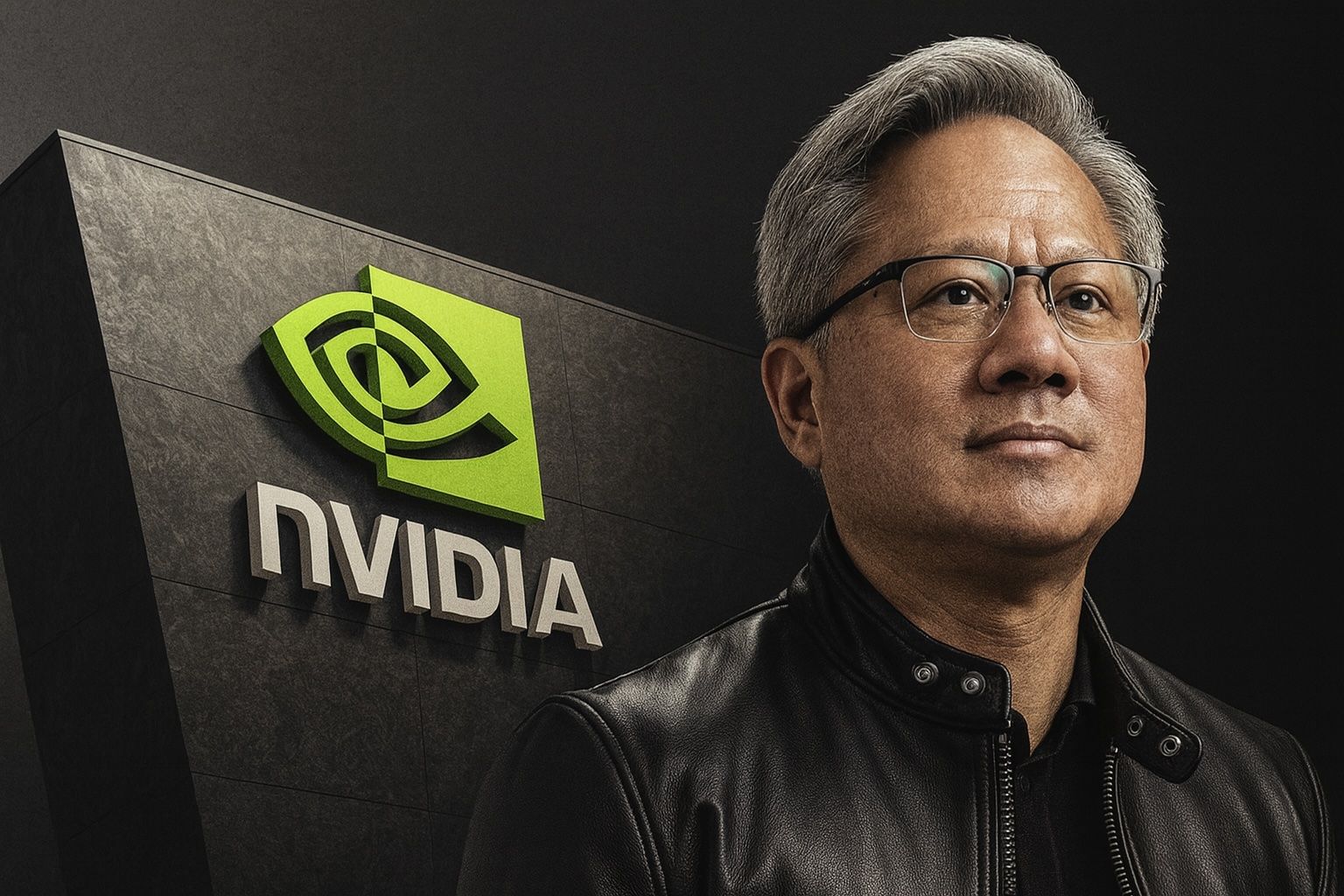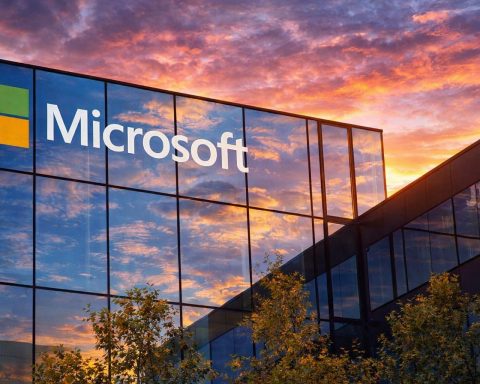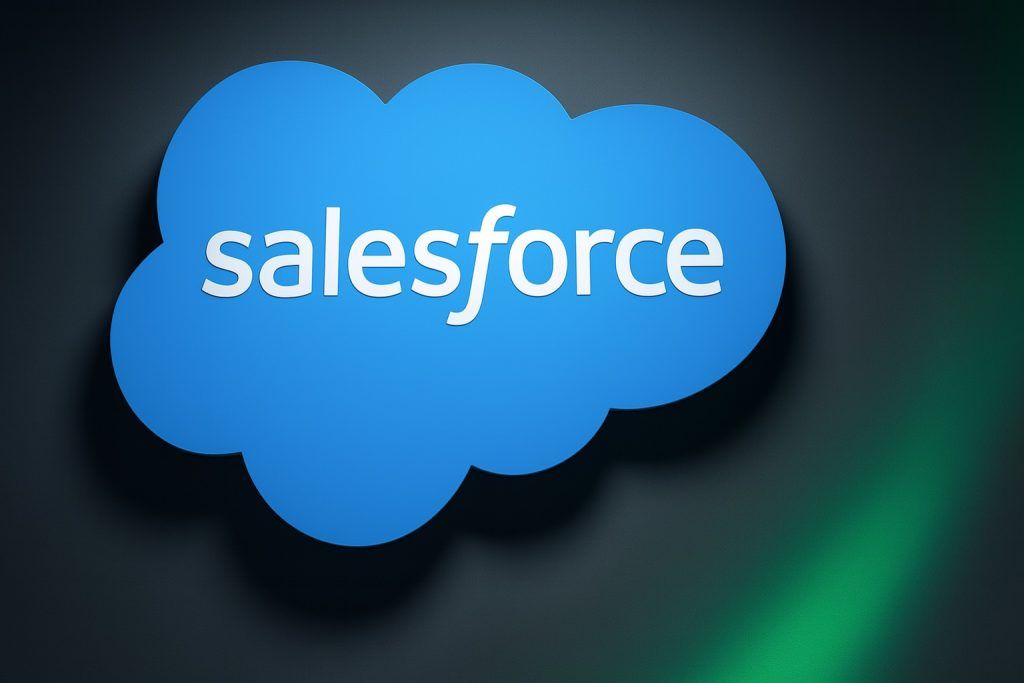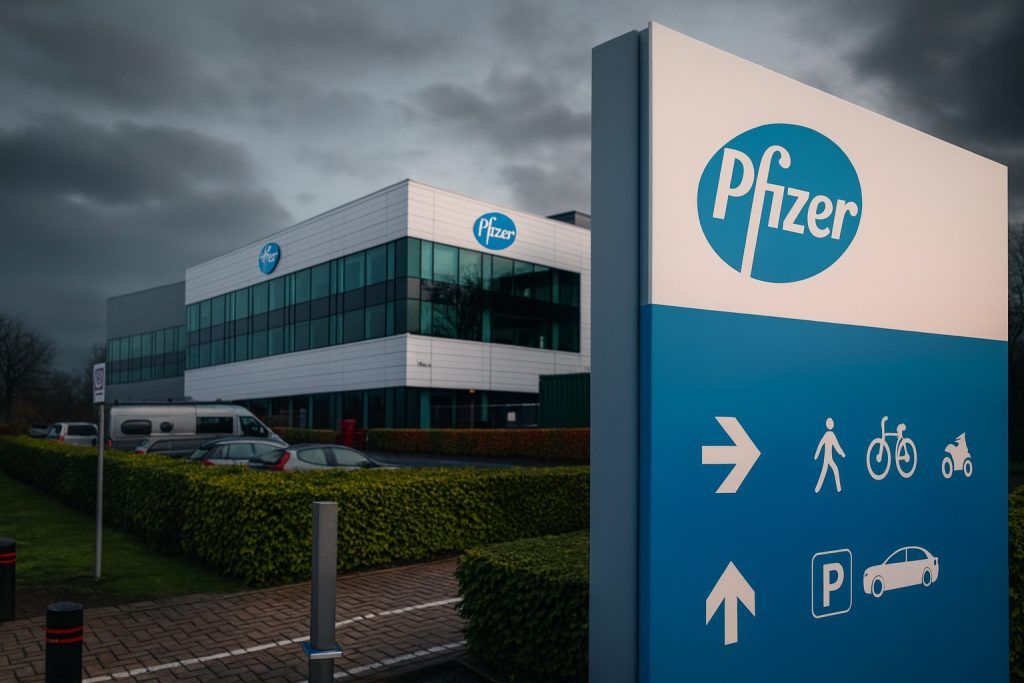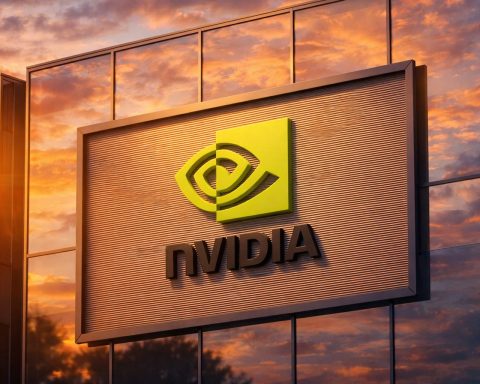- Record-shattering rally: NVIDIA closed at a record $186.58 on Sept 30, up ~2.6% that day, lifting its market value above $4.5 trillion – a first for any company [1]. The stock is up ~39% year-to-date [2], far outpacing most mega-cap tech peers.
- AI mega-deals: The surge is driven by huge AI partnerships. On Sept 22 NVIDIA announced it will invest up to $100 billion in OpenAI and supply massive data-center GPUs, immediately popping the share price ~3.9% higher [3]. In mid-September it also agreed to a $5 billion stake in Intel (with a joint chip pact), which sent Intel up ~23% and gave NVIDIA’s stock another boost [4] [5].
- “Stargate” infrastructure boom: NVIDIA GPUs are central to the $500 billion Stargate AI data-center project (a U.S.-led effort by OpenAI/Oracle/SoftBank) [6]. For example, the Norway leg will deploy 100,000 NVIDIA chips (expandable 10×) [7]. In the UK, a new plan calls for ~120,000 Blackwell GPUs and £11 billion in AI data centers by 2026 [8] – the country’s largest-ever AI rollout.
- Analysts bullish: Wall Street is overwhelmingly positive. Citi just raised its 12-month NVDA target to $210 [9], and KeyBanc/Barclays have “Buy” ratings with targets around $240–$250 [10]. On average, 42 analysts rate NVDA a “Strong Buy” with a $206 consensus target (≈10% above current) [11]. Citi’s Atif Malik explains: “OpenAI came to Nvidia asking for help as Nvidia has a very compelling product” [12].
- Robust fundamentals: In Q2 FY2026 (ended July 27) NVIDIA reported $46.7 billion revenue (+56% YoY) [13], driven by data-center demand. CEO Jensen Huang says the new Blackwell Ultra GPUs are “ramping at full speed, and demand is extraordinary” [14]. NVDA just returned $24 billion via buybacks and approved another $60 billion program [15]. The company guides Q3 (~Oct 2025) revenue around $54.0 billion [16], further growth if achieved.
- AI boom context: The broader tech investment boom magnifies NVDA’s rise. Microsoft and Meta plan to spend $80 billion and $60 billion (respectively) on AI data centers [17]. NVIDIA’s chips today comprise roughly 70–80% of the compute in new AI centers [18] [19]. Rival cloud providers (CoreWeave, Oracle, etc.) are locking in NVIDIA platforms – e.g. CoreWeave agreed to build $14.2 billion of GPU infrastructure for Meta [20].
- Tech competition: Rivals aren’t idle. AMD’s AI GPU sales are much smaller (Q2 DC revenue $3.2 B [21]), but CEO Lisa Su says its new MI355 accelerator is “very competitive versus the [Nvidia] B200, GB200” series [22]. AMD is pushing next-gen MI400 chips for 2026. Big cloud firms (Meta, Google, Amazon) are also designing in-house AI chips to hedge their bets [23] [24]. Meta just moved to acquire AI chip startup Rivos to boost its own silicon plans [25], and OpenAI is finalizing a custom AI chip design for future releases [26].
- Risks & valuation: NVIDIA’s P/E is sky-high (~53× trailing earnings) [27]. Some analysts caution about a “profit problem” (own deals like funding OpenAI create “circular” demand) and a “power problem” – AI GPUs consume vast energy [28]. Geopolitical tensions could bite: China recently opened an antitrust probe into NVIDIA and U.S. export controls still restrict top chips there [29]. Any weakening of AI spending could pressure the richly valued stock.
Market Rally and News Headlines
By early October 2025, NVIDIA has become the poster child of the AI-fueled stock surge. In late September, the Fed’s first rate cut in years (Sept 17) sparked a broad tech rally [30], but NVIDIA’s gains were driven by its own news flow. On Sept 22 the company announced a shock $100 billion partnership with OpenAI – NVIDIA taking an equity stake and supplying state-of-the-art data-center GPUs – and the stock promptly jumped about 4% [31]. A week earlier, NVDA had unveiled a $5 billion investment in Intel (to co-develop chips) [32]; that news powered Intel up 23% and added to NVDA’s momentum (the stock rose ~3.8% that day). Wall Street promptly hammered home the impact: eMarketer’s Gadjo Sevilla called the Intel deal “a massive game-changer for Intel” that “resets its position” in AI infrastructure [33].
By Sept 30, buoyed by those deal announcements and the AI spending frenzy, NVIDIA shares closed at $186.58, a new all-time high that put its market cap over $4.5 trillion [34]. That day’s ~2.6% gain was described as historic – NVDA is “the first company to top $4.5 trillion” in value [35]. As LiveMint noted, this milestone capped a meteoric climb (Nvidia hit $1T in May 2023, $2T in Feb 2024, $3T in June 2024, $4T in July 2025, and now $4.5T) [36]. The stock’s 39% jump YTD far outpaces the broader market [37]. Importantly, NVIDIA’s stock performance has beaten all other megacaps in 2025 – aside from Broadcom (also up ~40% on AI strength) [38].
On Oct 1 itself the stock held near those highs (closing $187.24) with no major negative news, and all attention stayed on the headline-grabbing AI deals. In fact, reporters noted that CoreWeave – a cloud provider partly owned by NVIDIA – had just struck a $14.2 billion GPU deal with Meta (Facebook) to build out AI infrastructure [39], further underscoring NVIDIA’s inescapable role. Analysts at Citi quickly lifted their NVDA price target to $210 (from $200) on Oct 1, saying the OpenAI collaboration pointed to even more AI spending ahead [40].
Blockbuster AI Partnerships
Central to NVDA’s recent rally are its massive new partnerships. The marquee announcement was the OpenAI tie-up on Sept 22. NVIDIA will invest $10 billion immediately (up to $100 billion total) for a share of OpenAI, and commit to deploying at least 10 gigawatts of GPU-accelerated compute to train AI models [41]. In practical terms, OpenAI and partners (including Oracle) plan to build hundreds of thousands of Nvidia chips into new data centers – for example, five major “Oracle Cloud” GPU facilities were unveiled as part of a $500 billion plan [42] [43]. Jensen Huang emphasizes that NVIDIA products now account for roughly 70% of the capital spending in new AI data centers [44].
Just days after the OpenAI deal, on Sept 25 NVidia announced the Intel pact: NVDA will pay $23.28 per share (~4% premium) for a 4% stake in Intel, and work with Intel to build custom AI CPUs that plug into NVIDIA GPU servers [45] [46]. This is a strategic win-win: it gives Intel fresh funding and puts it into NVIDIA’s server ecosystem; it also signals that NVIDIA’s GPU offerings will support integrated systems. The market reacted strongly – Intel stock exploded higher, and NVIDIA rose again.
Other deals in late Sept reinforced the trend. NVIDIA partnered with CoreWeave in a $14.2 billion contract to supply Meta with GPU-based AI infrastructure [47]. In the UK, NVIDIA announced a plan to co-fund “AI factories” with local firms (Microsoft, Nscale, etc.) deploying over 120,000 Blackwell GPUs (~£11 billion) by 2026 [48]. These projects are billed as the UK’s largest-ever AI infrastructure build. In short, NVIDIA’s technology has become the linchpin of major new AI data centers worldwide.
NVIDIA CEO Jensen Huang has publicly noted that its Blackwell-generation GPUs are driving this cycle: “Blackwell is the AI platform the world has been waiting for… production of Blackwell Ultra is ramping at full speed, and demand is extraordinary” [49]. That ‘extraordinary’ demand underpins all the deals – OpenAI, Oracle, Microsoft, Meta, the UK government and others are all pouring resources into NVDA-powered facilities.
Financial Performance & Outlook
NVIDIA’s latest results (for Q2 FY2026) show why the stock is surging. The company reported $46.7 billion in revenue for Q2 (ended July 27), up 56% from a year earlier [50]. Data center sales were $41.1 billion (up 56% YoY), driven by flagship Blackwell GPUs. GAAP gross margins were 72.4%, reflecting NVIDIA’s pricing power on cutting-edge chips [51]. On the earnings call, management approved an additional $60 billion buyback on top of the $14.7 billion remaining, highlighting how they plan to return cash to shareholders [52].
The guidance is also huge: NVIDIA’s outlook for Q3 (ending October 2025) called for about $54.0 billion in revenue (±2%) [53] – implying another double-digit percentage gain. Notably, this forecast assumes noshipments of the top-end H20 GPU into China this quarter [54], so any reopening of Chinese demand would be additional upside. CFO Colette Kress noted that demand for AI chips remains so strong that NVIDIA expects to exit 2025 with non-GAAP gross margins in the mid-70% range [55].
Even leaving aside AI, NVIDIA’s profitability is staggering. For Q2 it earned $26.4 billion GAAP net income ($1.08 per diluted share) [56] – figures many entire companies envy. That’s why analysts say NVIDIA’s 72%+ margins in AI chips are “unsustainable” by old tech standards, but for now they justify the valuation.
Industry Explosion & NVIDIA’s Dominance
NVIDIA didn’t rise in a vacuum. The whole semiconductor industry is riding an AI boom. Major tech companies are throwing money into new data centers: Microsoft is pledging $80 billion (2025) and Meta $60 billion (2026) for AI infrastructure [57]. These budgets underline the insatiable demand for GPUs. Today, NVIDIA reportedly controls about 80% of the chips used by the biggest AI model makers [58]. Even that huge share is testament to how far ahead NVIDIA is – no other GPU provider comes close in performance for training large language models.
Every real money provider now wants into NVIDIA’s ecosystem. Take the “Stargate” project: co-led by OpenAI, it plans for 10 gigawatts of data-center capacity [59]. NVIDIA supplies those data centers’ brainpower. Reuters reports that Oracle/OpenAI will add up to 4.5 GW on top of existing sites, and the Norway “Stargate” site will initially install 100,000 Nvidia chips (with potential to expand tenfold) [60]. NVIDIA has even agreed to invest up to $100 billion in OpenAI – essentially underwriting the project with both cash and hardware [61].
Similar relationships exist in Europe and Asia. NVIDIA is working with EU governments to build national AI clouds (e.g. France’s first industrial AI cloud) [62]. In Japan and Korea, its GPUs will power new supercomputers (e.g. Microsoft’s Azure supercomputer in the UK with 24,000 Blackwell Ultra GPUs [63]). Every data-center builder – from IBM to Samsung to government-backed firms like UAE’s G42 – lists NVIDIA as a core partner on flagship AI projects [64].
Technically, NVIDIA remains in a league of its own. Its recent “Blackwell Ultra” GPUs just smashed inference benchmarks – up to 1.4× the prior best on new models [65] [66]. This gap is real: NVIDIA has set MLPerf records across dozens of benchmarks, demonstrating a clear performance lead. This dominant technology position (and broad software ecosystem with CUDA) is why customers keep flocking to NVIDIA.
Competition and Rival Chips
Not everyone expects NVIDIA to hold the throne forever. AMD and Intel are on the march. AMD’s data-center sales are still small (Q2 DC revenue just $3.24 B [67]), but AMD CEO Lisa Su is touting momentum: shipments of its new Instinct MI355 AI accelerator have begun, and Google, Oracle and others have launched instances with MI300-series GPUs. Su says the MI355 is “competitive versus the [Nvidia] B200, GB200 family” [68], and that AMD has “clear path” to scale its AI business by several tens of billions in coming years [69]. AMD also recently regained a U.S. license to ship its MI300 chips to China, removing a key bottleneck [70].
Meanwhile, the big cloud players are hedging against any one-chip bottleneck. Meta (Facebook) is acquiring AI chip startup Rivos to speed development of its in-house “MTIA” accelerators [71]. Google and Amazon have long pursued their own chips (Google’s TPUs, Amazon’s Inferentia/Grafana), and OpenAI itself has quietly built a 40-person chip team. Reuters reports OpenAI is finalizing its first in-house training chip design (fabricated by TSMC) to reduce NVIDIA dependence [72]. The message: although today’s models use thousands of NVIDIA GPUs, tomorrow’s AI war might be fueled partly by custom chips.
Intel is also trying to close the gap. Beyond the NVDA partnership, Intel has its own Gaudi and Falcon LLM chips (from acquired Habana Labs) and is planning a new “Neural Processing Unit.” Its long-term play is clearer now that NVIDIA is effectively deputizing it to build CPUs that link to NVidia GPUs. Indeed, Reuters analysts note that NVIDIA’s deal may ultimately pose a bigger risk to foundries like TSMC than to AMD – if NVIDIA starts outsourcing production to Intel’s fabs, TSMC could lose a chunk of business [73].
Analysts’ Take and Forecasts
The consensus narrative is that NVIDIA’s momentum is likely to continue, at least in the near term. As of late Sept, analyst ratings were overwhelmingly positive: on StockAnalysis.com 23 of 42 analysts rate NVDA a “Strong Buy” and 17 a “Buy,” with only one Hold [74]. The average 12-month target price is ~$206 [75]. Notable firms are even higher: KeyBanc’s John Vinh and Barclays’ Tom O’Malley left NVDA at “Buy” and see ~$240–$250 targets [76], citing the de-risking effect of the OpenAI tie-up. Citi’s Atif Malik (now with a $210 target) explains that NVIDIA’s products are essentially indispensable to OpenAI’s growth [77].
Technically, market observers note NVDA has been in an overbought position. Some short-term traders look to support around $170–$180, noting the stock pulled back slightly after its Sept 30 high. However, momentum indicators remain strong. With interest rates easing, tech is in favor and NVIDIA’s chart shows a steep uptrend since late August. (As a benchmark, the S&P 500 and Nasdaq were hitting records in late Sept – NVIDIA simply went even further than most.)
Fundamentally, bulls point out that NVIDIA is still early in the AI growth story. Even at $4.5T it trades at ~50× trailing earnings [78], or about 39× forward – high, but arguably justified by the 60%+ revenue growth rates. NVDA’s return on equity and cash flow margins dwarf peers. Its balance sheet is pristine (net cash positive by billions) and it continues to expand margins as it scales.
Risks and Outlook
That said, there are headwinds that analysts and journalists are watching. Valuation alone is often cited as a risk: an embedded assumption is that NVIDIA will keep growing by ~50%+ annually. Any miss in sales or margins could trigger a sharp pullback. Some analysts warn of a “profit problem”: by funding customers (OpenAI) and pricing its chips so high, NVIDIA is essentially crowning itself king of the AI ecosystem – but that could invite backlash or limit the true demand. AInvest.com noted that buying back customers’ spending (e.g. a $100 B OpenAI bill essentially goes back to NVDA) might not reflect organic growth [79].
A “power problem” is also looming. GPUs consume enormous electricity, and a recent MIT-linked analysis highlighted that current AI chips are not energy-efficient [80]. Data-center operators are increasingly conscious of power/thermal limits. Competitors (including Chinese chip designers) are touting lower-power architectures. If a radical new chip (e.g. ARM-based or next-gen memory) emerges, it could chip away at NVIDIA’s advantage.
Geopolitics adds uncertainty. China has been cool to NVIDIA – in September its regulators opened a fresh antitrust probe [81]. U.S. export controls still bar NVIDIA’s very top chips from China, limiting sales (even though lower-tier H20 GPUs just won back permission). Any flare-up in the U.S.-China tech war could tighten these restrictions or reduce Chinese cloud spending. Conversely, U.S. industrial policy is NVDA-friendly: for example, the U.S. earlier arranged that 15% of NVIDIA’s H20 GPU revenue would serve domestic projects. Changes in U.S. policy (like subsidies or export relaxations) would affect NVDA’s growth trajectory.
In short, NVIDIA is riding a historic wave. Its recent moves have cemented it at the center of the AI boom – a position few analysts expected even a few years ago. Many observers believe the path ahead is more about “AI fundamentals” (customer wins, chip architecture, ecosystem strength) than about finding the “next market,” which bodes well for NVDA. As Mint’s Vaamanaa Sethi summarized on Oct 1, NVIDIA’s rise is reshaping market norms: “Nvidia’s path is more than a success story, it is an indication of how artificial intelligence is reshaping… global markets” [82].
Still, the scale of expectations invites caution. For now, investors seem willing to forgive rich valuations in exchange for leadership in what may be a multi-decade AI cycle. The coming weeks will test whether NVIDIA can keep meeting these sky-high targets: the big numbers in its forecast (Q3 $54B, mid-70s% margins) and the continued execution of its deal pipeline. In the short term, analysts see more upside – but many now watch for signs of overheating (e.g. profit-taking or regulatory news). Long-term, NVIDIA’s fate hinges on maintaining its technology lead as rivals ramp up R&D.
Sources: Recent NVIDIA earnings releases [83] [84], Reuters and news coverage of major announcements [85] [86] [87] [88] [89], and market analysis pieces [90] [91] [92]. These provide the data and expert quotes (e.g. Jensen Huang, Lisa Su, Atif Malik, Gadjo Sevilla) that underpin the above report.
References
1. www.livemint.com, 2. www.livemint.com, 3. www.reuters.com, 4. www.reuters.com, 5. www.reuters.com, 6. www.reuters.com, 7. www.reuters.com, 8. nvidianews.nvidia.com, 9. www.livemint.com, 10. stockanalysis.com, 11. stockanalysis.com, 12. www.livemint.com, 13. nvidianews.nvidia.com, 14. nvidianews.nvidia.com, 15. nvidianews.nvidia.com, 16. nvidianews.nvidia.com, 17. www.reuters.com, 18. www.livemint.com, 19. www.reuters.com, 20. www.livemint.com, 21. www.datacenterdynamics.com, 22. www.datacenterdynamics.com, 23. www.reuters.com, 24. www.reuters.com, 25. www.reuters.com, 26. www.reuters.com, 27. fullratio.com, 28. www.ainvest.com, 29. www.ainvest.com, 30. www.reuters.com, 31. www.reuters.com, 32. www.reuters.com, 33. www.reuters.com, 34. www.livemint.com, 35. www.livemint.com, 36. www.livemint.com, 37. www.livemint.com, 38. www.livemint.com, 39. www.livemint.com, 40. www.livemint.com, 41. www.reuters.com, 42. www.livemint.com, 43. www.reuters.com, 44. www.livemint.com, 45. www.reuters.com, 46. www.reuters.com, 47. www.livemint.com, 48. nvidianews.nvidia.com, 49. nvidianews.nvidia.com, 50. nvidianews.nvidia.com, 51. nvidianews.nvidia.com, 52. nvidianews.nvidia.com, 53. nvidianews.nvidia.com, 54. nvidianews.nvidia.com, 55. nvidianews.nvidia.com, 56. nvidianews.nvidia.com, 57. www.reuters.com, 58. www.reuters.com, 59. www.reuters.com, 60. www.reuters.com, 61. www.reuters.com, 62. nvidianews.nvidia.com, 63. nvidianews.nvidia.com, 64. www.reuters.com, 65. developer.nvidia.com, 66. developer.nvidia.com, 67. www.datacenterdynamics.com, 68. www.datacenterdynamics.com, 69. www.datacenterdynamics.com, 70. www.datacenterdynamics.com, 71. www.reuters.com, 72. www.reuters.com, 73. www.reuters.com, 74. stockanalysis.com, 75. stockanalysis.com, 76. stockanalysis.com, 77. www.livemint.com, 78. fullratio.com, 79. www.ainvest.com, 80. www.ainvest.com, 81. www.ainvest.com, 82. www.techi.com, 83. nvidianews.nvidia.com, 84. nvidianews.nvidia.com, 85. www.reuters.com, 86. www.reuters.com, 87. www.reuters.com, 88. www.reuters.com, 89. www.livemint.com, 90. stockanalysis.com, 91. www.datacenterdynamics.com, 92. www.ainvest.com
